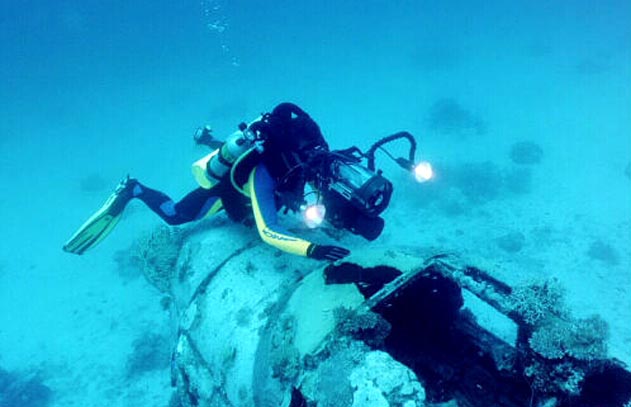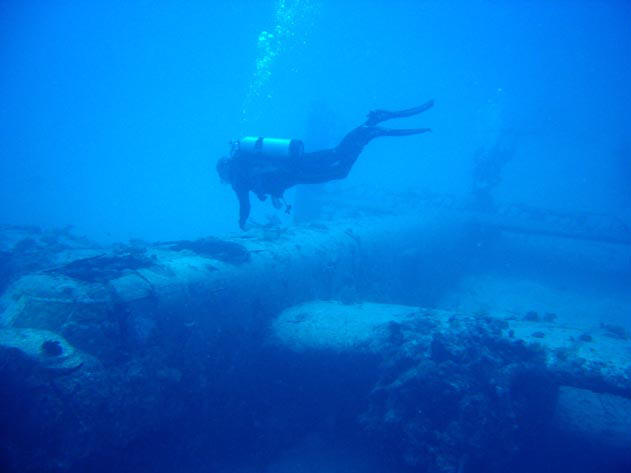|
|
||
|
|
||
|
|
DISPOSAL OF AIRCRAFT: PAGE 1 Following V-J Day, the Marine Corps faced the need for a rapid demobilization. With their job finished, the men who had fought the war were anxious to return home as quickly as possible so they could "get on with their lives." The American public was equally anxious to bring the men back home. In light of that need, it was decided to scrap all of VMB-613's aircraft rather than to transport them back to the United States. As a result, four of VMB-613s aircraft were stripped of their usable equipment on Kwajalein, then pushed into the dump by a bulldozer to await their final fate. While in the dump one aircraft caught fire and was destroyed. The remaining three were broken up and dumped into the ocean at Kwajalein. The squadron's remaining 11 aircraft were flown to Roi Island during October 1945 to be stripped and stricken from the roles of the Bureau of Aeronautics. At Roi, members of VMB-613's engineering department began removing usable equipment including engines and propellers, however this work was apparently cut short when the squadron received orders to return stateside. In haste, these aircraft were transferred to Carrier Aircraft Service Unit (Forward) Twenty (CASU-F-20) for disposal and the members of the squadron's engineering detachment returned to Kwajalein via an LST. Shortly thereafter, these aircraft were taken by barge into Kwajalein Lagoon, and near Mellu Island, were unceremoniously dumped overboard by working parties of CASU-F-20.
For many years these
aircraft rested undisturbed on the bottom of the lagoon. Although the
presence of at least one aircraft was known to local divers as early as
1966, little interest in their existence was shown. Then in 1989 diver
Bill Remick began researching the history of the aircraft at the bottom
of the lagoon. His research over the course of the next few years led
him to the conclusion that the B-25s were most likely VMB-613's PBJs—a
conclusion supported with evidence provided by VMB-613 members John
Gavin and Farley Lund. In 1995 Bill returned to Kwajalein, was able to
photograph one PBJ, and positively identified it as a VMB-613 aircraft
by the radome located on the starboard wingtip.
STRIPPED AIRCRAFT: During October 1945, squadron members began removing equipment form their PBJs on Roi prior to turning them over to CASU-F-20 for disposal. Here a PBJ-1H has had its 75mm cannon, and its engine and associated components removed. An empty mount for the 75mm cannon can be seen in the open panel directly below the pilot's compartment. Photograph: Farley R. Lund (Courtesy of Bill Remick)
CUT-UP ENGINE NACELLE: In the process of removing the engine and other worthwhile parts from this PBJ, most of the engine nacelle was cut off. Photograph: Farley R. Lund (Courtesy of Bill Remick)
THE END OF MB-8: MB-8 sits on its tail after being stripped of all its useful components. Shortly thereafter, it was dumped in the lagoon by CASU-F-20. Photograph: Farley R. Lund (Courtesy of Bill Remick)
NEXT IS MB-3: MB-3 is next to be stripped. Sitting on it's tail, it will soon suffer the same fate as MB-8 in the depths of the lagoon. Photograph: Farley R. Lund (Courtesy of Bill Remick)
ANOTHER STRIPPED PBJ: Like MB-8, this PBJ has had it cannon and engines removed in preparation for disposal. Photograph: Farley R. Lund (Courtesy of Bill Remick)
A SAD FAREWELL: Members of VMB-613 watch as one of their PBJs is towed away to be disposed. Photograph: Farley R. Lund (Courtesy of Bill Remick)
AIRCRAFT IDENTIFIED: In 1995, diver Bill Remick, following years of research located and photographed this PBJ and was able to positively identified it as one of VMB-613's aircraft. Photograph: ©1995 Bill Remick
PBJ REVEALED: Although submersed for over 55 years, VMB-613's PBJ-1H is totally devoid of paint but fairly intact and sitting upright on the lagoon's sandy bottom. Photograph: ©2001 Mark S. Miller
DIVERS DESCEND: During the summer of 2000, a dive team of the Oceanic Research Group located one of VMB-613's aircraft. It is located at a depth of approximately 120 feet in Kwajalein Lagoon near Roi Island. Note the remains of the radome on the starboard wingtip. Photograph: ©2001 Mark S. Miller
EXAMINING THE AIRCRAFT: Oceanic Research Group diver and expedition physician Christine Bird examines the upper fuselage of the aircraft. Note the absence of the front tire, the opening for the 75mm cannon, and the engine and cowling that has fallen to the sea floor. Photograph: ©2001 Jonathan Bird
FILMING THE COCKPIT: Perching on the nose of the aircraft, diver and cinematographer Greg (Gator) Brunshidle views the cockpit through the broken Plexiglas canopy. During the examination of the cockpit, diver and expedition leader Jonathan Bird noted that the aircraft's yoke was missing. Jon's observation suggests that the aircraft discovered may be MB-13 (Bureau Number 35267), whose pilot removed the yoke to keep as a souvenir before turning the aircraft over to CASU-F-20. Photograph: ©2001 Mark S. Miller
SITTING ON THE BOTTOM: A view of the starboard side of one of VMB-613's aircraft, now serving as a home for fish and other marine organisms. Barely visible on the lower surface of the starboard wing are the four sets of rocket launching rails. The area where this aircraft is located is littered with numerous aircraft and military vehicles. Photograph: ©2005 Dave Fortin
FRONT VIEW: A front view of one of VMB-613's aircraft. Although covered in marine life, the pilot's windscreen appears to be intact. In front of the windscreen is the slightly bent remnants of the ring-and-bead gun-sight post. Photograph: ©2005 Harold L. Parker
SECOND VMB-613 AIRCRAFT: A general view of a second VMB-613 PBJ reveals that the structure is fairly well intact with the exception of the nose, which has apparently fallen to the floor of the lagoon. Although the port engine has fallen to the sea floor, starboard engine appears remarkably to still be mounted to the heavily encrusted engine nacelle. Photograph: ©2005 Harold L. Parker
DIVER EXPLORES SECOND PBJ: Diver Hal Parker examines the second VMB-613 PBJ that is located in the aircraft dumping ground in Kwajalein Lagoon, south of Mellu Island. This aircraft appears to be in fairly good condition despite immersion in salt water for over 60 years. Photograph: ©2005 Scott Wallace
EMPENNAGE: The tail and tail gunners turret of one of VMB-613's PBJs. The large dark-colored object laying on the stabilizer is a truck chassis that was apparently dumped into the lagoon at the end of the war. Other truck parts lie in the background at the top-right of the photograph. Photograph: ©2005 Dave Fortin
TAIL TURRET: A close-up view of the aircraft's tail turret reveals the absence of the twin machine guns that had been removed prior to disposal. Although the fabric on the elevators has rotted away, the gunner's canopy remains intact. Photograph: ©2005 Dave Fortin
COCKPIT: Taken by diver, Dave Fortin, this photograph shows the condition of the cockpit of the PBJ in the accompanying photographs. Clearly visible are the throttle and propeller control levers on the control pedestal. The rust-colored object in the lower left is the control column which is missing the pilot's yoke. Photograph: ©2005 Dave Fortin
PILOT'S CENTER CONSOLE: A close-up of the pilot's center console reveals the throttle and propeller controls. The entire cockpit area now serves as a home for small reef fish. Photograph: ©2005 Dave Fortin
RADIO GUNNER'S COMPARTMENT: This photograph shows the condition of the radio-gunner's compartment on the port side of the aircraft. The mount for the .50 caliber machine gun can be clearly seen in the opening of the waist window. Photograph: ©2005 Harold L. Parker |
|
|
Copyright © 2008 Marine Bombing Squadron Six-Thirteen Association. All Rights Reserved. |
||




















